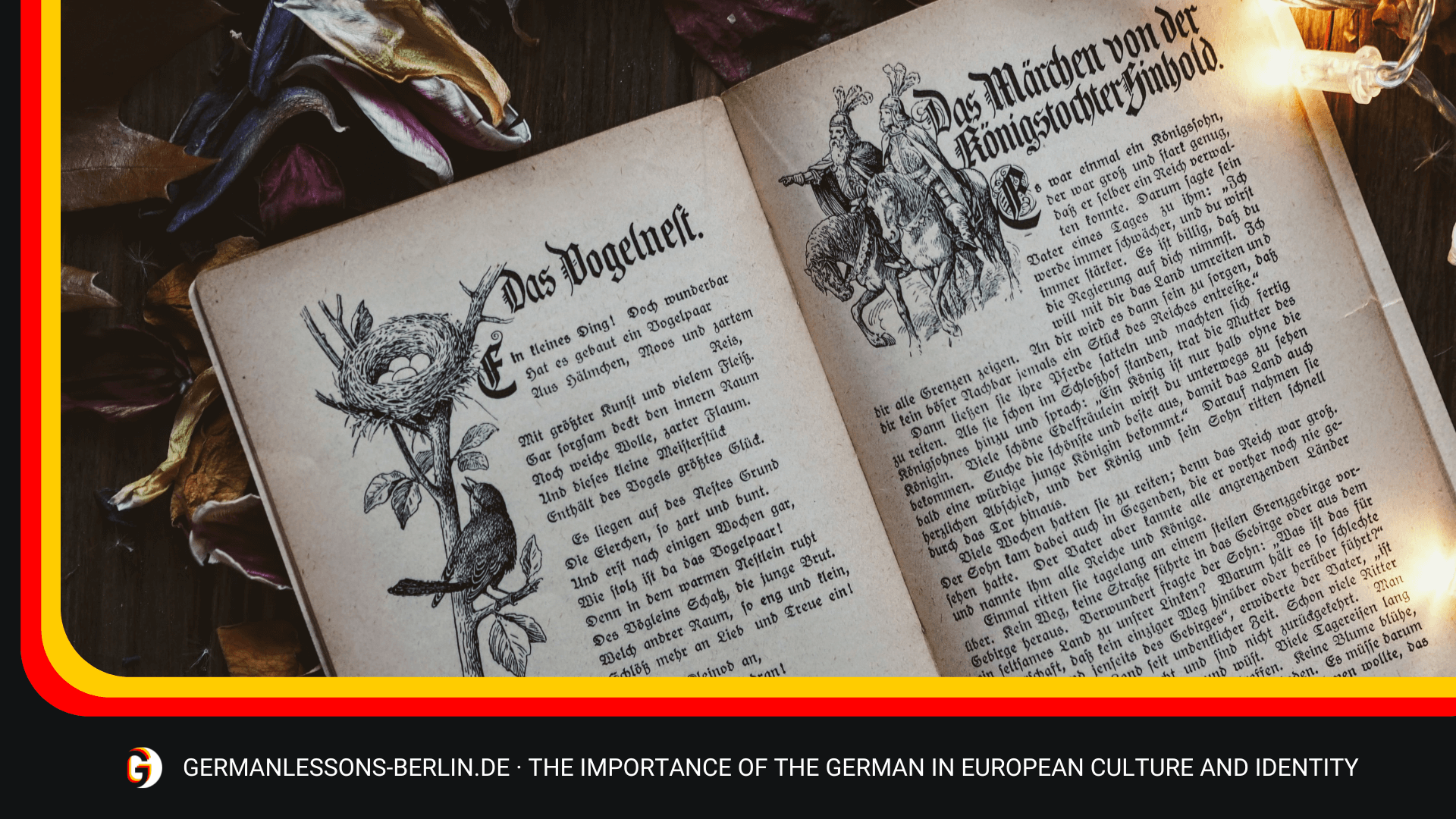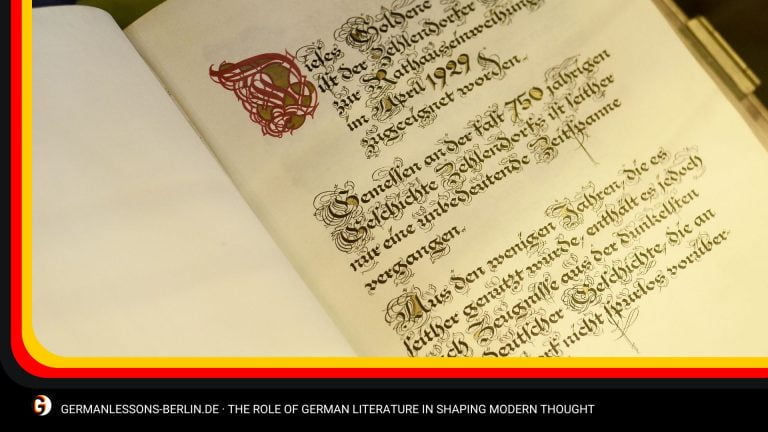The German language is an integral part of European culture and identity. It has been the dominant language for centuries, influencing all aspects of life. This article will explore the importance of German in European culture and identity, emphasizing that knowledge of this language can provide a greater appreciation for different cultures and more meaningful connections with fellow Europeans.
German has had a long-standing influence on Europe since before modern times; its roots reach back to at least the 1st century AD when it was used by Roman authors such as Tacitus. The language spread throughout Europe during the Middle Ages, becoming one of several significant languages used across the continent. As German became increasingly widespread among Europeans, so did its influence over their cultural identities and beliefs. For instance, some countries adopted German words into their vocabularies to better understand each other’s thoughts and feelings. Similarly, specific political movements have also drawn heavily upon ideas expressed through German writing or speech.
Today, knowing German provides individuals access to a wealth of material related to the history and culture of Europe, which would otherwise be inaccessible due to language barriers. Moreover, familiarity with this language allows citizens to develop deeper connections within their communities while helping them gain insight into different perspectives surrounding shared values and aspirations. By understanding these relationships between Germany and Europe’s past and present, we can begin to appreciate how essential German is for preserving our collective sense of freedom.
Table of Contents
History And Influence Of the German Language
The German language is an integral part of European culture and identity, providing a cornerstone to its history. It has played a significant role in shaping the continent’s past, and its influence can still be felt today on many levels. From its germanic roots that date back centuries to its linguistic impact on other languages such as English and Dutch, German has had an undeniable presence throughout Europe.
From literature to philosophy and science, German has been used by countless intellectuals to express their ideas. The works of renowned authors like Goethe, Kant, and Nietzsche have become essential to our global cultural heritage. With words like “schadenfreude” or “wanderlust” entering the vocabularies of millions worldwide, Germany’s unique linguistic contributions continue to shape us all.
The scope of German’s reach is remarkable; one could argue that no other language carries with it so much historical depth and germanic influence that continues to this day in modern times. As we look into the future, there is no doubt that German will remain a vital thread weaving through the tapestry of European Union culture and identity – connecting people from different countries together in tangible and intangible ways.
Significance In The European Union
The German language has a significant role in the European Union. It is used in all EU institutions and publications and translations from other languages into German. This makes it essential for communication between different countries and promotes vital unity. Furthermore, it is a necessary language for business transactions within the EU.
In terms of culture, the significance of German lies mainly in its regional varieties. These unique expressions form part of national identities throughout Europe and beyond. They are present in many global arts, such as literature and music, providing an insight into local cultures and traditions. Consequently, learning or understanding these varieties can help foster mutual understanding across borders and gives people a shared sense of identity rooted in Europe’s diversity.
Access to German allows individuals to explore this rich heritage by engaging with works written originally in this language. It also opens up opportunities for travel within Germany itself or even further afield – allowing exploration of places where various dialects are spoken or customs practiced differently than what one might be familiar with at home. In doing so, we can gain invaluable insights through our experiences abroad. Thus, it is clear that knowledge of the German language plays an integral role in preserving European culture while facilitating greater understanding among Europeans.
Role In Education And Business
German is like a key to unlocking the doors of European culture, and it has been an integral part of various manifestations of education, business, and international cooperation. Learning German can open new opportunities for individuals seeking to pursue higher knowledge or participate in economic activities across borders.
The significance of the language is reflected in numerous language schools offering courses specifically aimed at helping students learn German. Furthermore, many educational institutions offer specialized classes to help those who wish to gain proficiency in understanding technical jargon and colloquial expressions associated with everyday conversations. Language exchanges are also encouraged amongst young adults interested in exploring areas outside their native countries through student exchange programs that allow them to practice the language with local people during their travels.
Businesses have also played an important role by making German essential for interaction among representatives from different parts of Europe. This helps break down cultural barriers and facilitates efficient international communication within transnational corporations. Consequently, learning German can be beneficial for finding employment abroad and expanding professional networks throughout Europe.
Popularity Around The Globe
The German language is spoken by over 130 million people worldwide, making it one of the most popular languages in Europe and around the globe. It has become crucial to many cultures and identities in countries like Germany, Austria, Switzerland, and Luxembourg.
In addition to its popularity among native speakers, learning German has also increased among non-native speakers. According to recent surveys conducted by The European Commission, more than 8 million students outside of German-speaking countries have chosen to learn the language.
Learning German comes with numerous benefits for both students and businesses alike:
- Students:
- Improved academic opportunities – Students can pursue higher education at renowned universities such as Freie Universität Berlin or Technische Universität München.
- Enhanced career prospects – Having German-language skills gives job seekers an advantage when competing internationally.
- Businesses:
- Easier access to new markets – Companies that use German can tap into previously untapped markets by expanding their reach beyond just English-speaking customers.
- Increased global presence – As more companies start using German in their communications, they will be able to create stronger connections with customers from different parts of the world.
These factors have led to a surge in demand for qualified teachers, increased availability of resources and materials online, and growth in dedicated centers teaching the language worldwide. This has made it easier for individuals and organizations looking to acquire or improve their German-language skills. Moreover, these developments have helped foster strong ties between German-speaking communities everywhere, further cementing its importance worldwide. With this growing popularity, it’s easy to understand why so many embrace and appreciate the role of German in Europe’s culture and identity today.
As western societies continue to promote diversity through multilingualism, understanding how languages interact becomes increasingly essential; exploring the relationship between other tongues and German provides us with invaluable insight into our collective pasts and futures.
Relationship With Other Languages
German is closely related to many European languages, making it an essential part of the continent’s culture and identity. It shares a common root with French, English, Polish, Russian, and Danish, forming a linguistic family tree passed down through generations. This shared heritage gives people from different countries access to each other’s cultures in ways that would otherwise be impossible due to their geographic distance or political barriers.
German-French relations are particularly noteworthy; both countries have used the language as a bridge across centuries of conflict. France was once home to significant numbers of German speakers who could communicate easily between their respective nations. Similarly, Germany has strong ties with England and Poland; both countries contain large populations of native German speakers who use the language for everyday communication. Germany also maintains close relationships with Russia and Denmark, where native German speakers live among local communities.
These connections demonstrate how language can provide insight into another country’s history and traditions, even when physical contact is limited. Learning about its relationship with other tongues gives one a greater understanding of Germany’s role in shaping Europe’s cultural landscape over time. Through such exchanges via language – whether spoken or written – individuals become more aware of their unique identities within the context of a larger community. As we move into an increasingly globalized world, these bonds will continue to provide opportunities for cross-cultural dialogue and exchange on topics ranging from politics to art.
Cultural Exchange Through Language
Language can unite nations while fostering a sense of belonging and identity. German is a language that has immensely influenced European culture and identity throughout history. It is not only used as a means of communication but also as a vessel for cultural exchange among different European countries. Through learning German – English translations, people gain access to diverse cultures and ideas from other parts of Europe. This dynamic form of language exchange creates opportunities for meaningful intercultural dialogue between individuals and groups.
The importance of mastering foreign languages lies in their ability to give meaning to words and expressions beyond literal understanding. By developing linguistic proficiency through language learning, people can find common ground with others across national boundaries and bridge divides created by differences in culture or beliefs. Through this cultural exchange, they can develop mutual respect’s backgrounds and foster stronger community relationships.
Language plays an essential role in forming shared identities amongst Europeans, allowing them to connect on a deeper level than what would be possible without it. As we move into an increasingly globalized world, it becomes even more essential to recognize how deeply intertwined our fates are with those around us – no matter where we come from or which language we speak.
German Dialects & Regional Varieties
The German language is a vital part of the European cultural identity, with wide regional varieties across countries. German dialects are crucial to understanding how this language has diversified over time, and localized variations have been created in different regions. The dialectal differences between Standard German (Hochdeutsch) and regional dialects show how the language has evolved over centuries into various forms. This diversity can be seen in words, grammar rules, pronunciation, intonation, and even syntax, which often varies depending on where it is spoken.
The importance of german dialects lies in their contribution to the local culture through folk stories and traditional music, among other artistic elements. In addition to preserving certain aspects of the language as they are passed down from generation to generation, these dialects also help create distinct identities for each region and foster a sense of community within them. Furthermore, studying these variations can provide insight into the history behind certain expressions or phrases that may not have survived otherwise.
By recognizing the role german dialects play in Europe’s cultural heritage, we gain an appreciation for linguistic diversity that goes beyond borders and boundaries set by politics and geography. Understanding how languages change over time allows us to appreciate more fully what makes each corner of Europe unique while gaining a valuable perspective on our place within its landscape. As such, German dialects are indispensable in creating a united yet diverse European identity that simultaneously celebrates unity and individuality.
Contribution To Global Arts & Literature
The German language has contributed to global arts and literature. Its influence can be seen in art, music, film, theatre, and writing worldwide. From Goethe’s Faust to Mann’s Death in Venice, from Brecht’s Mother Courage to Grass’ Tin Drum, authors have expressed their ideas through the medium of this rich European language for centuries. Indeed, many argue that it is only through its use that some aspects of the culture have managed to survive over time and remain relevant today.
| German Literature | Arts Contribution | Global Influence |
| Goethe’s Faust | Music | Theatre |
| Mann’s Death | Film | Writing |
| Brecht’s Mother | Art | Language Exchange |
In addition to being a source of creative expression, German has also proved invaluable as a tool for communication between people with different cultural backgrounds. However, while it may serve as an international bridge linking cultures together, there is no denying that its primary role remains in providing Europe with a common identity. For example, understanding how the various nations interact within the EU requires knowledge not just of English but also German. This mutual exchange helps foster appreciation and respect among those involved, thus promoting peace and stability throughout the continent.
By connecting Europeans who speak different languages – including other minority tongues such as Dutch or Danish – German is a vital unifying force within Europe’s diverse landscape. In doing so, it allows individuals to express themselves more freely than before, offering them access to new opportunities and experiences that would otherwise remain inaccessible due to linguistic barriers. As such, it plays an important part in preserving Europe’s unique cultural heritage while at the same time encouraging diversity amongst its inhabitants.
Impact On National Identity & Pride
The German language has profoundly influenced national identity and pride across Europe. It is closely linked to German culture, history, and values that have shaped the European continent for centuries. As such, it can be seen as an integral part of many nations’ identities throughout the region.
The impact of the German language on national identity goes beyond simply speaking the same tongue; its presence in everyday life shapes how people think about themselves and their nation’s place within the wider European community. For example, those living in countries with strong German cultural influences often take great pride in sharing similar customs or traditions with other Europeans who may speak different languages but share common values and beliefs. This feeling of collective belonging helps foster a sense of shared identity among individuals from various European backgrounds.
Through its continued use in popular culture, education systems, business practices, media outlets, and more, the importance of the german language remains deeply rooted in European culture today. This sense of national pride has been critical in Germany, where the language is a powerful symbol of unity among citizens regardless of background or class. The prominence of German-speaking communities throughout Europe has also reinforced this idea over time, helping to create a strong bond between Germans at home and abroad.
Future Of The German Language
It’s the future, and German is still alive and kicking! For those concerned about its longevity in Europe, here is why it will remain a crucial language for many years to come:
- Its cultural impact: German has had an immense influence on the culture of much of Europe since it was first introduced centuries ago. It continues to be seen as a strong voice of authority and stability in the region.
- Future learning: As technology advances, so does the use of German in educational settings. Many universities now offer courses teaching students how to read, write and speak German fluently. This ensures that knowledge remains within reach for generations to come.
- Global relevance: With Germany’s recent surge in economic power, their language is becoming increasingly important globally – especially with multinational companies looking to expand into new markets or recruit talented employees abroad.
- Connecting cultures: Lastly, by speaking German, people can connect across different countries and cultures, allowing them to develop a better understanding of communities that would otherwise be disconnected due to geography or language barriers.
The importance of retaining this valuable part of European identity must be recognized; with it, our continent becomes much more diverse and vibrant. Fortunately, though, there will always be enough people willing to keep pushing forward with learning and preserving the beautiful sound that is German today – ensuring it lives on into tomorrow!
Frequently Asked Questions
What Are The Most Common German Dialects Spoken Today?
German dialects have been integral to the German language for centuries and are still very much used today. Commonly spoken German dialects range from regional to modern, with each one having unique characteristics that distinguish it from other language varieties. This article will explore some of these most common dialects and how they can be used by those interested in learning or speaking German.
One of the most widely-spoken modern dialects is High German (Hochdeutsch). Standard written German heavily influences high German but also has several distinct features which make it stand out from other varieties of the language. It is commonly used as a lingua franca among speakers of different regional dialects due to its widespread popularity. Additionally, many movies, television programs, and books feature characters who speak this variant of the language.
Another prominent type of German dialect is Low German (Plattdeutsch), which was historically famous across Northern Germany and parts of Holland before being displaced by High German during World War II. Despite this displacement, Low German remains an important cultural identity marker for many northern Germans and Dutch people and continues to be spoken amongst them daily. Other notable examples include Swiss German (Schweizerdeutsch) and Yiddish (Jüdisch), which have significantly shaped the culture, history, and identity of various European communities and beyond.
These diverse variants play an essential role in enriching our understanding of the wider world and contributing to a sense of community within European societies. By providing us with insights into different cultures’ histories, traditions, and languages, we become better able to appreciate their nuances while connecting more deeply with their shared identities on a global scale.
How Has The German Language Changed Over Time?
The German language has undergone significant transformations throughout its long history. The evolution of the language can be traced back to its Indo-European roots, showing how other languages influenced it in Europe over time. It is an essential component of European culture and identity, with modern German dialects spoken by millions today.
The development of the German language has been a complex process that includes a variety of influences from different cultures as well as changes within the language itself. Over hundreds of years, various forms have emerged, including Old High German, Middle Low German, and Early New High German. Each period saw certain features being added or removed from the prior version while still keeping many elements recognizable even today.
This constant evolution has facilitated the spread of German across Europe and beyond. As one of the most widely spoken languages on the continent, it played an influential role in shaping regional cultures and identities over centuries. Its influence can also be seen in other international contexts, such as literature, music, and science, where it continues to contribute.
Although much about the german language has changed since its origin, some aspects remain consistent through time; for example, its grammar structure remains largely intact despite all the shifts in phonology, morphology, and syntax observed over time. This makes learning contemporary forms more accessible for those familiar with older versions allowing them to continue communicating effectively using modern dialects without having to start from scratch once again.
Are There Any Language Programs Available To Learn German?
Learning a foreign language is no small feat, particularly one as distinct and complex as German. Fortunately, several options are available to those interested in studying the language. From immersive courses to self-guided tutorials, prospective students of the German language have their pick of programs to choose from.
Language learning programs offer tailored instruction for different levels of proficiency. Beginners may opt for an introductory course, while more advanced speakers can find comprehensive classes that cover all aspects of the language’s grammar, syntax, and vocabulary. Special topics such as business German or conversational practice can also be attended separately or incorporated into larger packages.
Whichever option best suits your needs, there is plenty of resources online dedicated to teaching the German language. Online services often provide access to experienced instructors who use interactive tools like video chat rooms and virtual whiteboards to facilitate learning in real-time. Additionally, many websites feature downloadable audio files with native pronunciations so you can practice your accents even offline.
With these tools at your disposal, acquiring fluency in the German language has never been easier – allowing everyone access to this vibrant culture regardless of where they live or how much free time they have on their hands. All it takes is dedication and commitment: soon enough, you’ll speak like a local!
What Is The Most Popular Use Of German In International Business?
German is not only a vital element of European culture and identity, but it has also become an essential language for global commerce. With the increasing interconnectivity of the world, countries that speak German are witnessing a rise in the use of their language in day-to-day business dealings. In this discussion, we will explore some of the most prevalent applications of the German language in international business, including negotiations, documentation, and presentations.
In today’s globalized economy, businesses seek ways to expand into new markets. For example, companies that wish to enter the German market must learn how to communicate effectively with potential customers and partners who speak German fluently. Understanding the nuances associated with this language can give foreign companies a competitive edge when negotiating contracts or presenting ideas. Additionally, many documents used by businesses require accurate translation into German if they are to be accepted as valid within Germany and other parts of Europe where German is widely spoken.
Businesses operating across borders often rely on experienced bilingual employees or contract interpreters to conduct meetings and produce translations without errors or misunderstandings. However, those tasked with managing overseas operations should also consider investing in specialized programs designed to teach staff members how to use the language efficiently for business purposes. Such courses usually focus on such issues as corporate etiquette and protocol; legal terminology; financial reports; marketing materials; customer service; and so forth—all tailored specifically for people working in an international context.
With its growing presence on the world stage, mastering the art of conducting business in German has never been more critical than it is today. From enhancing communication capabilities between team members located in different regions over multiple time zones to making sure every document produced meets local standards – knowledge about popular german business trends could be an invaluable asset for any organization wishing to succeed in modern times. Companies that seize this opportunity will find themselves well-positioned to reap long-term rewards from their investments in learning this valuable skill set.
Are There Any Other Languages Related To German?
German is an important European language, with many variants and dialects spoken across the continent. The most common form of German is High-German, used as a standard throughout Germany, Austria, Switzerland, and Liechtenstein. However, other forms of the language have developed over time due to regional influences. Low German is found mainly in northern Germany, while Austrian German and Swiss-German are distinct from their respective country’s official versions of High German. Franconian-German is also present in certain areas, such as Bavaria and parts of Thuringia.
These different varieties can be seen in everyday life for those living within the regions where they are spoken. For example, some school textbooks may be written using Low Germans. In contrast, documents related to business or government will often use a combination of High-, Austrian-, Swiss- or Franconian-Germans depending on the context. This demonstrates how each region has its unique linguistic identity – one allowing them to express themselves more freely than if they were restricted to only speaking High German.
In addition to this variety within German itself, it’s also interesting to note that several languages related to German have been influenced by it over the centuries. These include Dutch, Yiddish, and Afrikaans; all three have adopted various aspects of grammar and vocabulary from German at some point during their development:
– Dutch shares numerous grammatical structures with German such as verb conjugation patterns and word order.
– Yiddish uses several loanwords from German, including nouns like ‘bildung’ (education).
– Afrikaans has borrowed much of its vocabulary directly from German words such as ‘wagen’ (car).
– Frisian was once heavily reliant upon Old Saxon – a close relative of modern-day German – but still retains features that show its strong ties with the language today.
Overall, we can see that this vast language family contains many variations within itself and some intriguing connections outside too! As well as leading linguists studying these interrelated languages further, understanding them can help people feel connected with others who share similar cultural identities – granting us greater freedom in our expression and thought processes.
Conclusion
The German language has a long and complex history, with many dialects. The idioms today include Standard German and Swiss German. Over time, the language has evolved to become more unified in spelling, grammar, and pronunciation. This evolution reflects the changing cultural identity of Europeans and their relationship.
German is also a popular choice for international business due to its widespread presence across Europe. Companies can access skilled professionals from countries that speak different versions of German and other related languages, such as Dutch and Afrikaans. As Germany continues to be an essential economic powerhouse within the European Union, communicating effectively in German gives businesses an edge over competitors outside the EU market.
Language programs are available online and offline for those wishing to learn or improve their skills in German. Whether someone wants to brush up on their knowledge of this fascinating language or completely master it, they will find plenty of opportunities in educational institutions worldwide. Learning any new language can seem like climbing a mountain, but with dedication and commitment, anyone can reach the summit no matter how steep it may appear at first glance – much like a metaphor for life itself!
In summary, German is one of the oldest European languages still used widely today, with several dialects representing different aspects of culture and identity across Europe’s various regions. Its growing use in international business makes it highly valuable, while its availability through learning programs makes it accessible to everyone who wishes to gain proficiency in it. With dedication and perseverance, you too can scale this linguistic mountain – if you want something badly enough, nothing should stand in your way!




